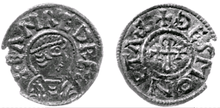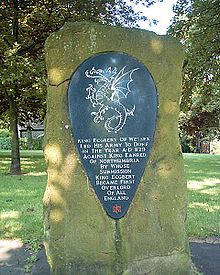Eanred
Eanred was king of the Anglo-Saxon kingdom of Northumbria from 808/810 to 840/841 or from 830 to around 854 .
Life
family
Eanred was the son of King Eardwulf (796-806? And 808? -810/830) of Northumbria. His mother was probably his first wife. He may have been a descendant of Eadwulf (705-706) from the Northumbrian royal family. Only his son Æthelred II is known as a descendant .
Domination
The rulers of this time are uncertain and contradictory for Northumbria. Symeon of Durham , a chronicler of the early 12th century, narrated that Eanred succeeded Ælfwald II (806–808) as king . Other historians, such as B. Simon Keynes consider a second term Eardwulfs possible, while in particular Kirby and Rollason assume that Eardwulf actually reigned a second time as King of Northumbria.
Eardwulf returned to Northumbria from exile in the year 808, accompanied by the deacon Aldulfus and the abbots Hruotfridus and Nantharius, and through the intervention of the Frankish ambassadors he came back to the throne. King Eardwulf's later life has not been recorded; even the date of his death is uncertain and is put around 810 or 830. According to Roger von Wendover , a 13th century chronicler , his son Eanred succeeded the throne in 810 and ruled until 840/841. On the basis of coin finds by Eanred, which for stylistic reasons was dated to around 850, Rollason takes the view that Eardwulf ruled until around 830, which also shifts the reigns of the later kings. (see the main article: List of the Kings of Northumbria )
Little is known about Eanred. The oldest statement comes from the Anglo-Saxon Chronicle and describes that in 829 Egbert von Wessex (802-839) “led an army in Northumbrian territory as far as Dore (near Sheffield ), where Egbert presented him with conditions of submission, and after he accepted , moved back home. ”This representation implies that the submission was triggered by the mere show of force of Egbert's march on the southern border of Northumbria. Roger von Wendover, however, reported that Egbert had devastated and looted Northumbria before Eanred paid him tribute . As a result, Egbert's hegemony expanded, if only briefly, over the whole of Anglo-Saxon Britain. After the unrest of the 8th and 9th centuries in Northumbria, Eanred's long reign indicated a ruler of great importance and unifying power, who was able to solve the existing problems. The good relations with the Carolingian court will also have been a stabilizing factor.
Under his predecessors Eardwulf and Ælfwald, coin production had almost come to a standstill. Eanred had stycas (silver coins with a very low fineness) minted in large quantities , over 600 of which have survived. The expansion of the coinage even beyond the borders of Northumbria indicates greater control and control of the economy by the king. The coins can be divided into two phases: while the early stycas had a fineness of 15 to 40%, the later specimens only have 5 to 15% silver.
When Eanred died around 840/841 or around 854, his son Æthelred II succeeded him as king.
swell
- anonymous: Anglo-Saxon Chronicle Online in Project Gutenberg (English)
- Symeon of Durham : Historia ecclesiae Dunelmensis (History of the Church of Durham)
- Roger von Wendover : Flores Historiarum
- anonymous: Annales regni Francorum Online at Wikisource (Latin.)
literature
- Barbara Yorke : Kings and Kingdoms of Early Anglo-Saxon England . Routledge, London-New York 2002, ISBN 978-0-415-16639-3 . PDF (6.2 MB)
- DP Kirby: The Earliest English Kings . Routledge, London-New York 2000, ISBN 978-0-415-24211-0 .
- Philip Grierson , Mark Blackburn : Medieval European Coinage 1. The Early Middle Ages (5th-10th centuries) , Cambridge University Press, Cambridge 2007 (paperback), ISBN 978-0-521-03177-6 .
- Barrie Cook, Gareth Williams (Eds.): Coinage and History in the North Sea World, c. AD 500-1200 . Brill, 2006, ISBN 978-90-04-14777-5 .
Web links
- David W. Rollason: Eardwulf (paid registration required). In: Oxford Dictionary of National Biography , Oxford University Press, 2004. Retrieved February 4, 2012
- Eanred in Foundation for Medieval Genealogy
Individual evidence
- ↑ a b c d e f g David W. Rollason: Eardwulf ( Memento of the original from December 9, 2012 in the Internet Archive ) Info: The archive link was automatically inserted and not yet checked. Please check the original and archive link according to the instructions and then remove this notice. (paid registration required). In: Oxford Dictionary of National Biography , Oxford University Press, 2004. Retrieved February 4, 2012
- ↑ a b c d e Simon Keynes: Kings of the Northumbrians . In: Lapidge et al. (Ed.): The Blackwell Encyclopaedia of Anglo-Saxon England . Wiley-Blackwell, Oxford et al. a. 2001, ISBN 978-0-631-22492-1 , pp. 502-505.
- ↑ Eanred in Foundation for Medieval Genealogy
- ^ Barbara Yorke: Kings and Kingdoms of Early Anglo-Saxon England . Routledge, London-New York 2002, ISBN 978-0-415-16639-3 , p. 89.
- ^ Barbara Yorke: Kings and Kingdoms of Early Anglo-Saxon England . Routledge, London-New York 2002, ISBN 978-0-415-16639-3 , p. 96.
- ^ Symeon of Durham: Historia ecclesiae Dunelmensis , 20. Likewise: Barbara Yorke: Kings and Kingdoms of Early Anglo-Saxon England . Routledge, London-New York 2002, ISBN 978-0-415-16639-3 , pp. 87 and 96.
- ↑ DP Kirby: The Earliest English Kings . Routledge, London-New York 2000, ISBN 978-0-415-24211-0 , p. 158
- ^ Annales Regni Francorum for the year 808 in The Latin Library in Latin
- ↑ Alex Woolf : From Pictland to Alba: 789-1070 Volume 2. Edinburgh University Press, 2007, ISBN 978-0-7486-1234-5 , pp. 68-69.
- ^ Anglo-Saxon Chronicle for the year 827
- ^ Philip Holdsworth: Northumbria . In: Lapidge et al. (Ed.): The Blackwell Encyclopaedia of Anglo-Saxon England . Wiley-Blackwell, Oxford et al. a. 2001, ISBN 978-0-631-22492-1 , pp. 334-335.
- ^ Barbara Yorke: Kings and Kingdoms of Early Anglo-Saxon England . Routledge, London-New York 2002, ISBN 978-0-415-16639-3 , p. 99.
- ↑ DP Kirby: The Earliest English Kings . Routledge, London-New York 2000, ISBN 978-0-415-24211-0 , p. 163.
- ^ A b Barbara Yorke: Kings and Kingdoms of Early Anglo-Saxon England . Routledge, London-New York 2002, ISBN 978-0-415-16639-3 , p. 97.
- ↑ Website ( Memento of the original dated August 7, 2011 in the Internet Archive ) Info: The archive link was inserted automatically and has not yet been checked. Please check the original and archive link according to the instructions and then remove this notice. of the Fitzwilliam Museum
- ^ Philip Grierson, Mark Blackburn : Medieval European Coinage 1. The Early Middle Ages (5th-10th centuries) , Cambridge University Press, Cambridge 2007 (paperback), ISBN 978-0-521-03177-6 , p. 588.
| predecessor | Office | successor |
|---|---|---|
| Eardwulf |
King of Northumbria 808 / 810-840 / 841 or 830-854 |
Æthelred II. |
| personal data | |
|---|---|
| SURNAME | Eanred |
| BRIEF DESCRIPTION | King of Northumbria |
| DATE OF BIRTH | 8th century or 9th century |
| DATE OF DEATH | 9th century |


